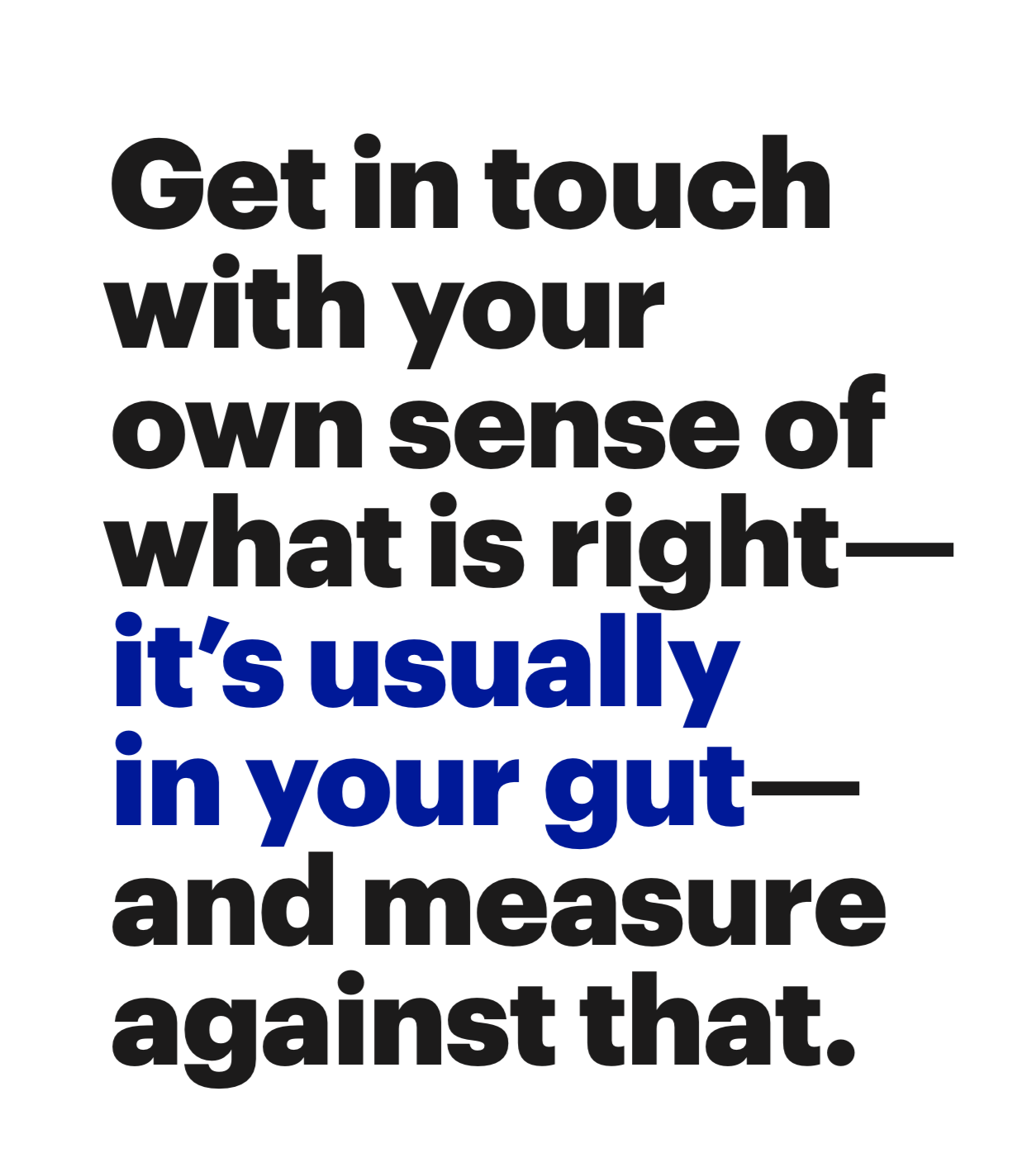Your gut knows
Malcolm Gladwell famously wrote about “Thin-slicing” in his book Blink: The Power of Thinking Without Thinking. The concept of thin-slicing is essentially the ability to find the pattern, the bigger picture, with only a small window of information. Years of experience come into play here and a definitive decision comes through, loud and clear. This isn’t guessing. This is your brain seeing the whole picture in an instant and finding the path forward. This is your gut.
As a creative leader, I have to make sure that whatever decisions I make have their foundations in research, data and metrics but product design is both science and art. There’s an instinctive, accumulative intelligence that comes from decades of working in a discipline, whether it’s wood-working or architecture or making rocket ships.
The big picture is often lost in the metrics. The Harvard Business Review recently published “Don’t Let Metrics Undermine Your Business,” in which the authors wrote:
“Tying performance metrics to strategy has become an accepted best practice over the past few decades. Strategy is abstract by definition, but metrics give strategy form, allowing our minds to grasp it more readily. With metrics, Ford Motor Company’s onetime strategy “Quality is job one” could be translated into Six Sigma performance standards. Apple’s “Think different” and Samsung’s “Create the future” could be linked to the amount of sales from new products. If strategy is the blueprint for building an organization, metrics are the concrete, wood, drywall, and bricks.
But there’s a hidden trap in this organizational architecture: A company can easily lose sight of its strategy and instead focus strictly on the metrics that are meant to represent it.”
Yes, you should have target goals. Yes, you should have vigorous data and research. And, yes, you should use KPI’s and OKR’s and whatever way you can measure progress (as Peter Drucker said, “If you can’t measure it, you can’t improve it”) but all this needs to be balanced against gut and vision.
It’s been my experience that the main issue is that hard data and research allow for incremental change. It’s safe. It’s conservative. It’s measurable. It’s the famous trap of the perhaps apocryphal quote by Henry Ford:
“If I had asked my customers what they wanted, they would have said a faster horse.”
And to build on this, Steve Jobs did say:
“It’s really hard to design products by focus groups. A lot of times, people don’t know what they want until you show it to them.”
It’s important to think big. Really big. What seems bananas at the moment is often just a matter of timing. In 2000, I met with music executives at Reprise Records, a subsidiary of Warner Music. I pitched the idea that Reprise should digitize their back catalog and allow, now get this, for people to listen to music on their mobile phones. Gasp. I said, It would be like radio. But on the phone. And that if a customer liked a song, they could push # to bookmark it and if they wanted to buy it, they could push *. The two executives looked at me with bemusement, well one did as the other was bored, and told me, “John, no one is ever going to listen to music on their f-ing phones. Ever. Now please leave.” And I did.
Even at CBS in the mid-2000’s, I was a big believer in the potential of the mobile screen, especially after the launch of the iPhone. To me, it seemed that it would just be a matter of time that the device would be an entertainment hub. I was overseeing cbs.com and called a meeting so that a new executive for our mobile strategy, Cyriac Roeding, could do a presentation on text messaging and how he used it to great effect in his previous company in Germany. I recall that after his presentation, that one of the web developers in the room raised his hand and said, Man, no one in America is ever going to text like that.
Meeting over.
Every new vision and tech meets resistance as being too “out-there.” If you are feeling this, you are probably not as out-there as you may feel. Your timing is just ahead.
This morning I received Peter Diamandis’ email newsletter in which he wrote about AR (augmented reality):
“Riding new advancements in hardware and connectivity, augmented reality (AR) is set to replace these 2D interfaces, instead allowing us to see through a digital information layer. And ultimately, AR headsets will immerse us in dynamic stories, learn-everywhere education, and even gamified work tasks.”
My gut tells me he’s right. What does yours tell you?
John
What I’m watching/listening to:
all the good girls go to hell by Billie Eilish (video) (thanks Audrey)
Cuz I love you by Lizzo (again, thanks Audrey)
Leaning Into The Wind: Andy Goldsworthy on Hulu
Gimme Danger a documentary on Iggy Pop & The Stooges by Jim Jarmusch
Free by Iggy Pop
What I’m reading/read:
The Rise of Superman by Steven Kotler
The Ocean at the End of the Lane by Neil Gaiman
From The Art of Creative Rebellion by John S. Couch
